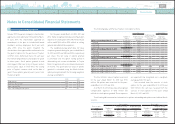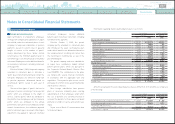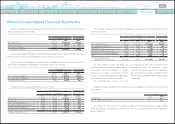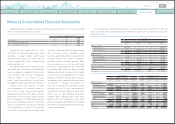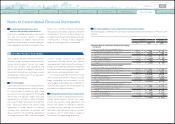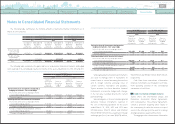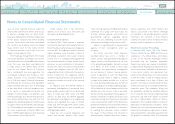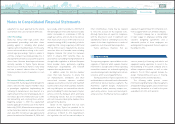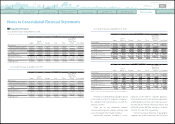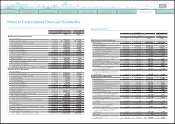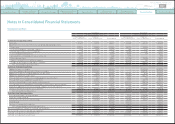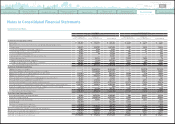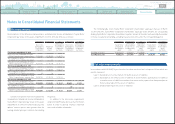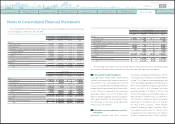Toyota 2012 Annual Report Download - page 112
Download and view the complete annual report
Please find page 112 of the 2012 Toyota annual report below. You can navigate through the pages in the report by either clicking on the pages listed below, or by using the keyword search tool below to find specific information within the annual report.
TOYOTA ANNUAL REPORT 2012
Toyota Global Vision Changes for Making
Ever-Better Cars President
ʼ
s Message Medium- to Long-Term
Growth Initiatives Special Feature Management and
Corporate Information Investor Information
Business and
Performance Review Financial Section
Notes to Consolidated Financial Statements
seek an order requiring Toyota to repair the
vehicles and claim that all owners and lessees
of vehicles, including those for which recalls
have been implemented, should be compensated
for the defects related to the antilock braking
systems. These cases have been consolidated
into 2 actions, one in federal court in the United
States District Court for the Central District
of California and one in state court in the Los
Angeles County Superior Court.
From February through March 2010, Toyota
was sued in 6 putative shareholder class actions
on behalf of investors in Toyota ADRs and common
stock. The cases have been consolidated into
a single action in the United States District
Court for the Central District of California,
and a lead plaintiff has been appointed. The
consolidated complaint, filed October 4, 2010,
alleges violations of the Securities Exchange
Act of 1934 and Japan
ʼ
s Financial Instruments
and Exchange Act on the basis that defendants
made statements that were false or misleading
in that they failed to disclose problems with,
or the causes of, unintended acceleration in a
number of vehicle models. The plaintiffs seek
monetary damages in an amount to be proven at
trial, interest and attorneys
ʼ
fees and costs. The
judge dismissed with prejudice the claims based
on Japan
ʼ
s Financial Instruments and Exchange
Act. The lead plaintiff has moved for certification
of a class of purchasers of Toyota
ʼ
s ADRs from
April 7, 2008 through February 2, 2010. A hearing
on the motion is set for July 23, 2012.
states
ʼ
attorneys general, including the Executive
Committee for a group of 30 states
ʼ
plus one
territory
ʼ
s attorney general, and certain local
governmental agencies regarding various
recalls, the facts underlying its recent recalls
and customer handling related to those recalls.
Toyota is cooperating with the government
agencies in their investigations, which are
on-going.
The recalls and other safety measures
described above have led to a number of
claims, lawsuits and government investigations
against Toyota in the United States as set forth
in the preceding paragraphs. Amounts accrued
as of March 31, 2012 related to these legal
proceedings and governmental investigations
are not material to Toyota
ʼ
s financial position,
results of operations or cash flow. Beyond the
amounts accrued, Toyota is unable to estimate
a range of reasonably possible loss, if any, for
the cases described above because
(
i
)
many of
the proceedings are in evidence gathering stages,
(
ii
)
the likelihood of classes being certified or the
ultimate size of the classes, if any, is uncertain,
(
iii
)
the outcome of pending or future appeals or
motions is unknown,
(
iv
)
significant factual issues
need to be resolved,
(
v
)
in some cases, novel legal
issues are presented, and/or
(
vi
)
the differences
between the matters as well as their interrelations
further complicate the prediction of outcomes.
In reaching this conclusion, Toyota considers
the stages of these matters, the discovery in
and information available about these matters,
Toyota believes that it has meritorious
defenses to all of these cases and claims, and
will vigorously defend against them.
In February 2010, Toyota received a subpoena
from the U.S. Attorney for the Southern District of
New York and a voluntary request and subpoena
from the SEC. The subpoenas and the voluntary
request primarily seek documents related to
unintended acceleration and certain financial
records. This is a coordinated investigation and
has included interviews of Toyota and non-Toyota
witnesses, as well as production of documents.
In June 2010, Toyota received a second voluntary
request and subpoena from the SEC and a
subpoena from the U.S. Attorney for the Southern
District of New York. The subpoenas and the
voluntary request primarily seek production of
documents related to the recalls of the steering
relay rod.
In February 2012, the NHTSA initiated a
preliminary investigation of a potentially faulty
power window master switch in the driver-side
doors in model year 2007 Camry and RAV4
vehicles. In June 2012, the NHTSA upgraded
the preliminary investigation to an engineering
analysis and expanded the scope to include
model year 2007 through 2009 Camry, Camry
hybrid, RAV4 and Yaris as well as model year
2008 Highlander hybrid.
Toyota has also received subpoenas and
formal and informal requests from various
Toyota
ʼ
s experience with similar matters and
Toyota
ʼ
s assessment of the matters. Although
an estimation is not possible based on current
information, the resolution of these matters
could have an adverse effect on Toyota
ʼ
s financial
position, results of operations or cash flows.
In February 2003, Toyota, GM, Ford, Daimler
Chrysler, Honda, Nissan, BMW and their sales
subsidiaries in the United States and Canada,
as well as the National Automobile Dealers
Association and the Canadian Automobile
Dealers Association were named as defendants
in approximately 85 purported federal and state
class action lawsuits on behalf of all purchasers
of new motor vehicles who purchased their
vehicles in the United States on or after January
1, 2001. As of April 1, 2005, the federal lawsuits
were consolidated in the State of Maine, and
lawsuits in the State of California and the State
of New Jersey were also consolidated within the
respective states. The complaints allege that
the defendants violated the Sherman Antitrust
Act or state anti-trust law by conspiring among
themselves and with their dealers to prevent
the sale to United States citizens of vehicles
produced for the Canadian market, resulting in
higher prices to United States consumers. Toyota
believes that its actions have been lawful. In the
interest of resolving these legal actions, however,
Toyota entered into a settlement agreement with
the plaintiffs in February 2006. The settlement
Government Investigations
United States Antitrust Proceedings
0820
Search NextPrev page 112
Contents


